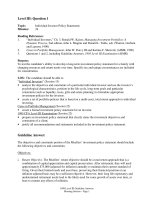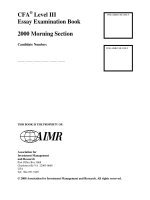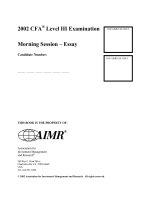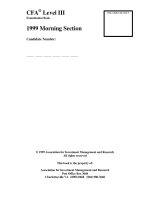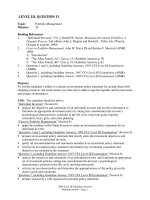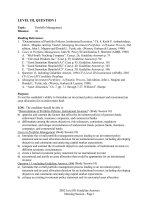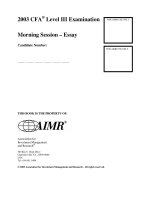L3 mock sample exam CFA level III essay questions 2002
Bạn đang xem bản rút gọn của tài liệu. Xem và tải ngay bản đầy đủ của tài liệu tại đây (194.2 KB, 34 trang )
2002 CFA® Level III Examination
FOR AIMR USE ONLY
Morning Session – Essay
Candidate Number:
FOR AIMR USE ONLY
_____ _____ _____ _____ _____ _____
THIS BOOK IS THE PROPERTY OF:
Association for
Investment Management
and Research®
560 Ray C. Hunt Drive
Charlottesville VA 22903-0668
USA
Tel: 434-951-5499
© 2002 Association for Investment Management and Research. All rights reserved.
The following list contains the command words used on the Morning Session of
the 2002 Level III examination. Candidates may want to refer to this list as they
formulate their answers.
Calculate:
To ascertain or determine by mathematical processes.
Describe:
To transmit a mental image, an impression, or an understanding of the nature
and characteristics of.
Determine:
To come to a decision as the result of investigation or reasoning; to settle or
decide by choice among alternatives or possibilities.
Discuss:
To discourse about through reasoning or argument; to present in detail.
Explain:
To give the meaning or significance of; to provide an understanding of; to give
the reason for or cause of.
Formulate:
To put in a systematized statement or expression; to prepare according to a
formula.
Identify:
To establish the identity of; to show or prove the sameness of.
Indicate:
To point out or point to with more or less exactness; to show or make known
with a fair degree of certainty.
Justify:
To prove or show to be valid, sound, or conforming to fact or reason; to
furnish grounds or evidence for.
Prepare:
To put into written form; to draw up.
Recommend:
To bring forward as being fit or worthy; to indicate as being one’s choice for
something or as otherwise having one’s approval or support.
The Morning Session of the 2002 CFA Level III Examination has 9 questions.
For grading purposes, the maximum point value for each question is equal to the
number of minutes allocated to that question.
Question
1
2
3
4
5
6
7
8
9
Topic
Portfolio Management
Portfolio Management
Portfolio Management
Portfolio Management
Portfolio Management
Portfolio Management
Portfolio Management
Asset Valuation
Asset Valuation
Total:
Minutes
26
11
22
16
36
15
22
14
18
180
Questions 1 through 4 relate to the endowment fund of Jarvis University. A total of 75
minutes is allocated to these questions. Candidates should answer these questions in the
order presented.
QUESTION 1 HAS TWO PARTS FOR A TOTAL OF 26 MINUTES.
Jarvis University (JU) is a private, multi-program U.S. university with a $2 billion endowment
fund as of fiscal year-end May 31, 2002. With little government support, JU is heavily
dependent on its endowment fund to support ongoing expenditures, especially because the
university’s enrollment growth and tuition revenue have not met expectations in recent years.
The endowment fund must make a $126 million annual contribution, which is indexed to
inflation, to JU’s general operating budget. The U.S. Consumer Price Index is expected to rise
2.5 percent annually and the U.S. higher education cost index is anticipated to rise 3 percent
annually. The endowment has also budgeted $200 million due on January 31, 2003, representing
the final payment for construction of a new main library.
In a recent capital campaign, JU only met its fundraising goal with the help of one very
successful alumna, Valerie Bremner, who donated $400 million of Bertocchi Oil and Gas
common stock at fiscal year-end May 31, 2002. Bertocchi Oil and Gas is a large-capitalization,
publicly traded U.S. company. Bremner donated the stock on the condition that no more than 25
percent of the initial number of shares may be sold in any fiscal year. No substantial additional
donations are expected in the future.
Given the large contribution to and distributions from the endowment fund, the endowment
fund’s Investment Committee has decided to revise the fund’s investment policy statement. The
Investment Committee also recognizes that a revised asset allocation may be warranted. The
asset allocation in place for the JU endowment fund as of May 31, 2002, is given in Exhibit 1-1.
Exhibit 1-1
Jarvis University Endowment Fund
Asset Allocation as of May 31, 2002
Current
Current
Current
Asset
Allocation Allocation
Yield
(millions) Percentage
U.S. Money Market Fund
$40
2%
4.0%
Intermediate Global Bond Fund
$60
3%
5.0%
Global Equity Fund
$300
15%
1.0%
Bertocchi Oil and Gas Common Stock
$400
20%
0.1%
Direct Real Estate
$700
35%
3.0%
Venture Capital
$500
25%
0.0%
Total
$2,000
100%
Expected
Annual
Return
4.0%
5.0%
10.0%
15.0%
11.5%
20.0%
Standard
Deviation
of Returns
2.0%
9.0%
15.0%
25.0%
16.5%
35.0%
A.
Prepare the components of an appropriate investment policy statement for the Jarvis
University endowment fund as of June 1, 2002, based only on the information given.
Note: Each component in your response must specifically address circumstances of the
JU endowment fund.
Answer Question 1-A in the Template provided on pages 5, 6, and 7.
(14 minutes)
B.
Determine the most appropriate revised allocation percentage for each asset in Exhibit
1-1 as of June 1, 2002. Justify each revised allocation percentage with one reason.
Note: Your response should include only one allocation percentage for each asset. The
revised allocation percentages for Direct Real Estate and Venture Capital are provided in
the Template on page 8.
Answer Question 1-B in the Template provided on page 8.
(12 minutes)
Answer Question 1 on This Page
Template for Question 1-A
Prepare the components of an appropriate investment policy statement for the
Jarvis University endowment fund as of June 1, 2002
OBJECTIVES
1.
2.
Template for Question 1-A continued on next page
Answer Question 1 on This Page
Template for Question 1-A (continued)
Prepare the components of an appropriate investment policy statement for the
Jarvis University endowment fund as of June 1, 2002
CONSTRAINTS
1.
2.
3.
Template for Question 1-A continued on next page
Answer Question 1 on This Page
Template for Question 1-A (continued)
Prepare the components of an appropriate investment policy statement for the
Jarvis University endowment fund as of June 1, 2002
CONSTRAINTS
4.
5.
Answer Question 1 on This Page
Template for Question 1-B
Your response should include only one allocation percentage for each asset. The revised
allocation percentages for Direct Real Estate and Venture Capital are provided in the template.
Determine the
most appropriate
revised allocation
Justify each revised allocation
Asset
percentage for
percentage with one reason
each asset as of
June 1, 2002
U.S. Money Market Fund
Intermediate Global Bond
Fund
Global Equity Fund
Bertocchi Oil and Gas
Common Stock
Direct Real Estate
10%
Not required
Venture Capital
Total
10%
100%
Not required
QUESTION 2 HAS TWO PARTS FOR A TOTAL OF 11 MINUTES.
Five years have passed and the Jarvis University endowment fund’s willingness and ability to
assume risk have increased. The endowment fund’s Investment Committee asks its consultant,
James Chan, to discuss and recommend a rebalancing strategy to incorporate the new risk
tolerance. Chan’s outlook is for a bull market in growth assets over the next three to five years.
He also believes that volatility will be below historical averages during that same time period.
The Investment Committee directs Chan to incorporate his views into his recommendation. The
Committee also does not want the market value of the portfolio to decline more than 15 percent
below its current market value.
A.
Describe the following three primary rebalancing strategies:
i.
ii.
iii.
Buy-and-hold
Constant-mix
Constant-proportion
(6 minutes)
B.
Determine which one of the three rebalancing strategies in Part A Chan should
recommend for the Jarvis University endowment fund. Justify your response with two
reasons based on the circumstances described above.
(5 minutes)
QUESTION 3 HAS THREE PARTS FOR A TOTAL OF 22 MINUTES.
James Chan is reviewing the performance of the global equity managers of the Jarvis University
endowment fund. Williamson Capital is currently the endowment fund’s only largecapitalization global equity manager. Performance data for Williamson Capital are shown in
Exhibit 3-1.
Exhibit 3-1
Williamson Capital
Performance Data 1990–2001
Average Annual Rate of Return
22.1%
Beta
1.2
Standard Deviation of Returns
16.8%
Chan also presents the endowment fund’s Investment Committee with performance information
for Joyner Asset Management, which is another large-capitalization global equity manager.
Performance data for Joyner Asset Management are shown in Exhibit 3-2.
Exhibit 3-2
Joyner Asset Management
Performance Data 1990–2001
Average Annual Rate of Return
24.2%
Beta
0.8
Standard Deviation of Returns
20.2%
Performance data for the relevant risk-free asset and market index are shown in Exhibit 3-3.
Exhibit 3-3
Relevant Risk-free Asset and Market Index
Performance Data 1990–2001
Risk-free Asset
Average Annual Rate of Return
5.0%
Market Index
Average Annual Rate of Return
18.9%
Standard Deviation of Returns
13.8%
A.
Calculate the following two performance measures for both Williamson Capital and
Joyner Asset Management:
i.
ii.
Sharpe ratio
Treynor measure
(4 minutes)
B.
Calculate the following five components of investment performance for Joyner Asset
Management, using only the performance data contained in Exhibits 3-2 and 3-3:
i.
ii.
iii.
iv.
v.
Overall performance
Risk
Selectivity
Diversification
Net selectivity
Note: Selected components of investment performance for Williamson Capital are
calculated in the first row of the Template on page 22.
Answer Question 3-B in the Template provided on page 22.
(10 minutes)
The Investment Committee notices that using the Sharpe ratio versus the Treynor measure
produces different performance rankings of Williamson and Joyner. Chan points out that using
overall performance versus net selectivity also produces different performance rankings of
Williamson and Joyner.
C.
Explain why different rankings of Williamson Capital and Joyner Asset Management
could result from using:
i.
ii.
The Sharpe ratio versus the Treynor measure
Overall performance versus net selectivity
(8 minutes)
Answer Question 3 on This Page
Template for Question 3-B
Selected components of investment performance for Williamson Capital are calculated in the
first row of the template.
Calculate the following five components of investment performance for
Joyner Asset Management
i.
Overall
performance
Williamson
Capital
Joyner Asset
Management
ii.
Risk
16.68
iii.
Selectivity
iv.
Diversification
v.
Net selectivity
0.24
0.18
QUESTION 4 HAS TWO PARTS FOR A TOTAL OF 16 MINUTES.
Bristol Capital Management is the intermediate global fixed income manager for the Jarvis
University endowment fund. Bristol has prepared the performance report shown in Exhibit 4-1.
James Chan reviews the report and tells the endowment fund’s Investment Committee that the
report is not Global Investment Performance Standards (GIPS®) compliant.
Exhibit 4-1
Bristol Capital Management
Performance Results: Intermediate Global Fixed Income Composite
January 1, 1997 through March 31, 2002
Total
Benchmark Number Composite Total assets Percentage
return
return
of
dispersion
at end of
of firm
(%)
(%)
portfolios
(%)
period
assets
(US$
(%)
millions)
12.7
10.7
8
6.6
512
21
9.5
7.2
12
4.7
780
23
2.1
1.5
22
6.5
1,250
27
14.2
14.1
25
3.0
1,425
32
4.9
6.1
29
1.9
1,712
35
7.1
5.9
34
4.4
1,994
37
Year
Total
firm
assets
(US$
millions)
2,438
3,391
4,629
4,453
4,891
5,389
1997
1998
1999
2000
2001
1st Qtr 2002
(Annualized)
Bristol Capital Management has prepared and presented this report in compliance with the Global
Investment Performance Standards®, except for the use of cash basis accounting for the recognition of
interest income.
Notes:
1.
Bristol Capital Management is an independent investment management firm founded in
November 1995.
2.
Performance results are presented before investment management and custodial fees.
3.
Valuations are computed quarterly and are denominated in U.S. dollars.
4.
Bristol Capital Management utilizes derivative products to enhance portfolio returns.
5.
All Intermediate Global Fixed Income accounts over $1 million are included in the
composite at the beginning of the first full quarter under management.
6.
Several non-fee paying accounts are included in the Intermediate Global Fixed Income
composite.
7.
Allied Verification, Ltd. has verified the Bristol Capital Management Intermediate
Global Fixed Income composite to be GIPS® compliant.
A.
Identify four items included in the Bristol Capital Management performance report that
are not compliant with GIPS.
Note: Omissions are not valid responses.
(8 minutes)
B.
Identify four omissions that prevent the Bristol Capital Management performance report
from being in compliance with GIPS.
(8 minutes)
Questions 5 through 7 relate to Claire Pierce. A total of 73 minutes is allocated to these
questions. Candidates should answer these questions in the order presented.
QUESTION 5 HAS FOUR PARTS FOR A TOTAL OF 36 MINUTES.
Claire Pierce, a vice president for Spencer Design, is a 42-year-old widow who is a resident of
the U.S. She has two children: a daughter, aged 21, and a son, aged 7. She has a $2,200,000
portfolio; half of the portfolio is invested in Spencer Design, a publicly traded common stock,
which has a cost basis of $350,000. Despite a substantial drop in the value of her portfolio over
the last two years, her long-term annual total returns have averaged 7 percent before tax. The
recent drop in value has caused her great anxiety, and she believes that she could no longer
tolerate an annual decline greater than 10 percent.
Pierce intends to retire in 20 years, and her goals, in order of priority, over the next 20 years are:
•
•
•
•
Funding the cost of her daughter’s upcoming final year of college, which has a
present value of $18,000, and her son’s future college costs, which have a present
value of $91,000
Increasing the portfolio to a level that will fund her retirement living expenses,
which she estimates to be $180,000 after tax for the first year of her retirement
Building her “dream house” in five years, the cost of which (including land) has a
present value of $375,000
Giving, if possible, each of her children $1,000,000 when they reach age 40
After subtracting the present value (before tax) of her children’s education costs and her
homebuilding costs, the present value of her portfolio is $1,509,000. With continued annual
growth of 7 percent before tax, the portfolio’s value will be approximately $3,928,000 at the end
of 20 years.
Pierce’s annual salary is $145,000, her annual living expenses are currently $100,000, and both
are expected to increase at an inflation rate of 3 percent annually. Taxes on income and shortterm capital gains (holding period one year or less) are substantially higher than taxes on longterm capital gains (holding period greater than one year). For planning purposes, Pierce wants to
assume that all returns are fully taxable and that her average tax rate on all income and gains is
30 percent. The inflation and tax rates are expected to remain constant. Currently, Pierce rents a
townhouse, has no debt, and adamantly intends to remain debt-free. Spencer Design has no
pension plan, but provides company-paid medical insurance for executives for life and for their
children to age 25. After tax, Pierce’s salary just covers her living expenses and therefore does
not allow her to make further meaningful capital contributions to her portfolio.
Pierce has prepared the following investment policy statement:
Claire Pierce Investment Policy Statement
The portfolio should be invested conservatively, as I want to protect its
principal value. My salary covers my current living expenses, but the
portfolio will need a moderate level of liquidity to cover the college
expenses. My desire to give each of my children one million dollars when
they reach age 40 requires the portfolio to have a long-term focus but allows
for a low return objective in keeping with my low risk tolerance. Because of
my tax circumstances, the portfolio should focus on securities that generate
little or no taxable income.
A.
Prepare the objectives portion of a new investment policy statement for Pierce.
Indicate how each of your two objectives addresses a different weakness in Pierce’s
current investment policy statement.
(12 minutes)
B.
Prepare the constraints portion of a new investment policy statement for Pierce.
Indicate how each of your four constraints addresses a different weakness in Pierce’s
current investment policy statement.
Note: The legal and regulatory constraint is not applicable and should not be included
among the constraints addressed in your response.
(12 minutes)
Pierce indicates that Spencer Design has a leading and growing market share, as the industry is
quite fragmented. The company has shown steady fundamental growth trends, and Pierce
intends to hold her Spencer Design stock, which is expected to return at least 9 percent annually
before tax with a standard deviation of returns of 20 percent. Pierce has decided to invest the
balance of her assets in one of the three alternative portfolios described in Exhibit 5-1.
Money Market
Bonds
Equities
Total
Exhibit 5-1
Claire Pierce
Alternative Portfolios for Balance of Assets
Expected
Annual
Portfolio A
Portfolio B
Portfolio C
Return
(before
tax)
$51,000
$51,000
$550,000
4.2%
$491,000
$792,000
$330,000
6.4%
$558,000
$257,000
$220,000
10.8%
$1,100,000
$1,100,000
$1,100,000
Standard
Deviation
of
Returns
2.5%
7.8%
17.8%
C.
Recommend which one of the three alternative portfolios in Exhibit 5-1 is most
appropriate for the balance of Pierce’s assets. Justify your recommendation with three
reasons.
(8 minutes)
Pierce is considering three alternative portfolio managers for that portion of her equity portfolio
that is not in Spencer Design stock. The average market return and standard deviation
characteristics and fees for each of the managers are expected to be very similar. The three
managers are further described in Exhibit 5-2.
Manager
F
G
H
D.
Exhibit 5-2
Claire Pierce
Alternative Portfolio Managers
Description
Manager of a portfolio that is equally weighted
among the stocks in the S&P 500 Index.
Portfolio holdings are adjusted quarterly.
Manager of a market-weighted value index
portfolio that consists of the half of the S&P 500
Index with the lowest price-to-book value ratios.
Portfolio holdings are adjusted quarterly.
Manager of an actively managed largecapitalization portfolio with an average holding
period of seven years.
Recommend which one of the three portfolio managers in Exhibit 5-2 is most
appropriate for Pierce’s equity portfolio. Justify your recommendation with one reason.
(4 minutes)
QUESTION 6 HAS ONE PART FOR A TOTAL OF 15 MINUTES.
Two years later, Claire Pierce comments on changes in her life circumstances:
“I must now support my parents who live overseas on Pogo Island. The Pogo Island
economy has grown rapidly over the past two years with minimal inflation, and
consensus forecasts call for a continuation of these favorable trends for the foreseeable
future. Economic growth has resulted from the export of a natural resource used in an
exciting new technology application.
“I want to invest 10 percent of my portfolio in Pogo Island government bonds. I plan to
purchase long-term bonds because my parents are likely to live more than 10 years.
Experts uniformly do not foresee a resurgence of inflation on Pogo Island, so I am certain
that the total returns produced by the bonds will cover my parents’ spending needs for
many years to come. There should be no exchange rate risk because the bonds are
denominated in local currency. I want to buy the Pogo Island bonds, but am not willing
to distort my portfolio’s long-term asset allocation to do so. The overall mix of stocks,
bonds, and other investments should not change. Therefore, I am considering selling one
of my U.S. bond funds to raise cash to buy the Pogo Island bonds. One possibility is my
High Yield Bond Fund, which has declined five percent in value year to date. I am not
excited about this Fund’s prospects; in fact I think it is likely to decline more, but there is
a small probability that it could recover very quickly. So I have decided instead to sell
my Core Bond Fund that has appreciated five percent this year. I expect this investment
to continue to deliver attractive returns, but there is a small chance this year’s gains
might disappear quickly.
“Once that shift is accomplished, my investments will be in great shape. The sole
exception is my Small Company Fund, which has performed poorly. I plan to sell this
investment as soon as the price increases to my original cost.”
Identify three behavioral finance concepts illustrated in Pierce’s comments and describe each of
the three concepts. Discuss how an investor practicing standard or traditional finance would
challenge each of the three concepts.
Answer Question 6 in the Template provided on pages 43 and 44.
(15 minutes)
Answer Question 6 on This Page
Template for Question 6
Identify three
behavioral finance
concepts illustrated
in Pierce’s comments
Describe each of the three
concepts
1.
2.
Template for Question 6 continued on next page
Discuss how an investor
practicing standard or
traditional finance would
challenge each of the
three concepts
Answer Question 6 on This Page
Template for Question 6 (continued)
Identify three
behavioral finance
concepts illustrated
in Pierce’s comments
3.
Describe each of the three
concepts
Discuss how an investor
practicing standard or
traditional finance would
challenge each of the
three concepts
QUESTION 7 HAS TWO PARTS FOR A TOTAL OF 22 MINUTES.
Claire Pierce, now 47 years old, has recently married a co-worker at Spencer Design. Pierce and
her husband are buying their dream house at a total cost of $550,000, and have decided to make
an immediate down payment of $300,000 and finance the remainder over 15 years. Pierce also
indicates that her son has contracted a rare disease, requiring major surgery; the disease will
prevent him from attending college. Although Pierce and her husband have medical insurance
that will pay her son’s ongoing medical expenses, her son’s surgery will cost an additional
$150,000 immediately. The cost of medical expenditures is expected to grow at a rate exceeding
the general inflation rate for the foreseeable future. Pierce has decided to quit work to care for
her son, whose remaining life expectancy is 40 years. She also insists on the need to provide
care for her son when she and her husband are no longer capable of doing so. Pierce’s parents
died one year ago and her daughter is now financially independent. Pierce’s husband intends to
retire in 25 years.
Given these circumstances, the investment portfolio held by Pierce and her husband will need to
provide an amount equal to $1,200,000 (present value) after tax to meet their living expenses
until retirement. They also want their portfolio to grow enough to cover their living expenses at
retirement, which they estimate to be $280,000 annually after tax. They believe a before-tax
portfolio growth rate of approximately 8 to 10 percent annually will be needed to achieve this
goal. Based on a retirement spending goal of $280,000, their corresponding effective postretirement spending rate will be approximately 6 to 7 percent annually before tax.
Pierce summarizes her new financial information in Exhibit 7-1. She indicates that her portfolio
and her husband’s portfolio should be considered as one. She further states that her husband has
taken well above-average risk in the past but he is now willing to leave the investment
management decisions to her.
Exhibit 7-1
Claire Pierce
New Financial Information
Claire
Pierce
Salary
Assets
Money Market
Diversified Bond Fund
Equities
Large-Capitalization Equities
Emerging Market Equities
Spencer Design Common Stock
Undeveloped Commercial Land
Total Portfolio
Husband
Current
Allocation
Percentage
Combined
of
Combined
Portfolio
$150,000
---
$0
$150,000
$61,000
$1,129,000
$27,000
$0
$88,000
$1,129,000
2.4%
30.5%
$385,000
$0
$1,325,000
$0
$2,900,000
$0
$407,000
$122,000
$244,000
$800,000
$385,000
$407,000
$1,447,000
$244,000
$3,700,000
10.4%
11.0%
39.1%
6.6%
100.0%
A.
Indicate how each component of Pierce’s investment policy statement should change as
a result of Pierce’s new circumstances. Justify each of your responses with two reasons
based on Pierce’s new circumstances.
Note: Your response should address only the components identified in the Template on
pages 49 and 50.
Answer Question 7-A in the Template provided on pages 49 and 50.
(12 minutes)
B.
Recommend whether the current allocation percentage (given in Exhibit 7-1) for each of
the following assets should be decreased or increased as a result of Pierce’s new
circumstances. Justify each of your responses with one reason based on Pierce’s new
circumstances.
i.
ii.
iii.
iv.
v.
vi.
Spencer Design Common Stock
Money Market
Diversified Bond Fund
Large-Capitalization Equities
Emerging Market Equities
Undeveloped Commercial Land
Note: The Spencer Design Common Stock row in the Template on page 51 is completed
as an example.
Answer Question 7-B in the Template provided on pages 51 and 52.
(10 minutes)
Answer Question 7 on This Page
Template for Question 7-A
Indicate how each
component of
Pierce’s investment
Component of
policy statement
Pierce’s investment
should change as a
policy statement
result of Pierce’s
new circumstances
(circle one)
Justify each of your responses with two
reasons based on Pierce’s new circumstances
1.
Lower
Return Requirement
No change
2.
Higher
1.
Lower
Risk Tolerance
No change
2.
Higher
Template for Question 7-A continued on next page
Answer Question 7 on This Page
Template for Question 7-A (continued)
Indicate how each
component of
Pierce’s investment
Component of
policy statement
Pierce’s investment
should change as a
policy statement
result of Pierce’s
new circumstances
(circle one)
Justify each of your responses with two
reasons based on Pierce’s new circumstances
1.
Lower
Liquidity
No change
2.
Higher
1.
Shorter
Time Horizon
No change
Longer
2.
